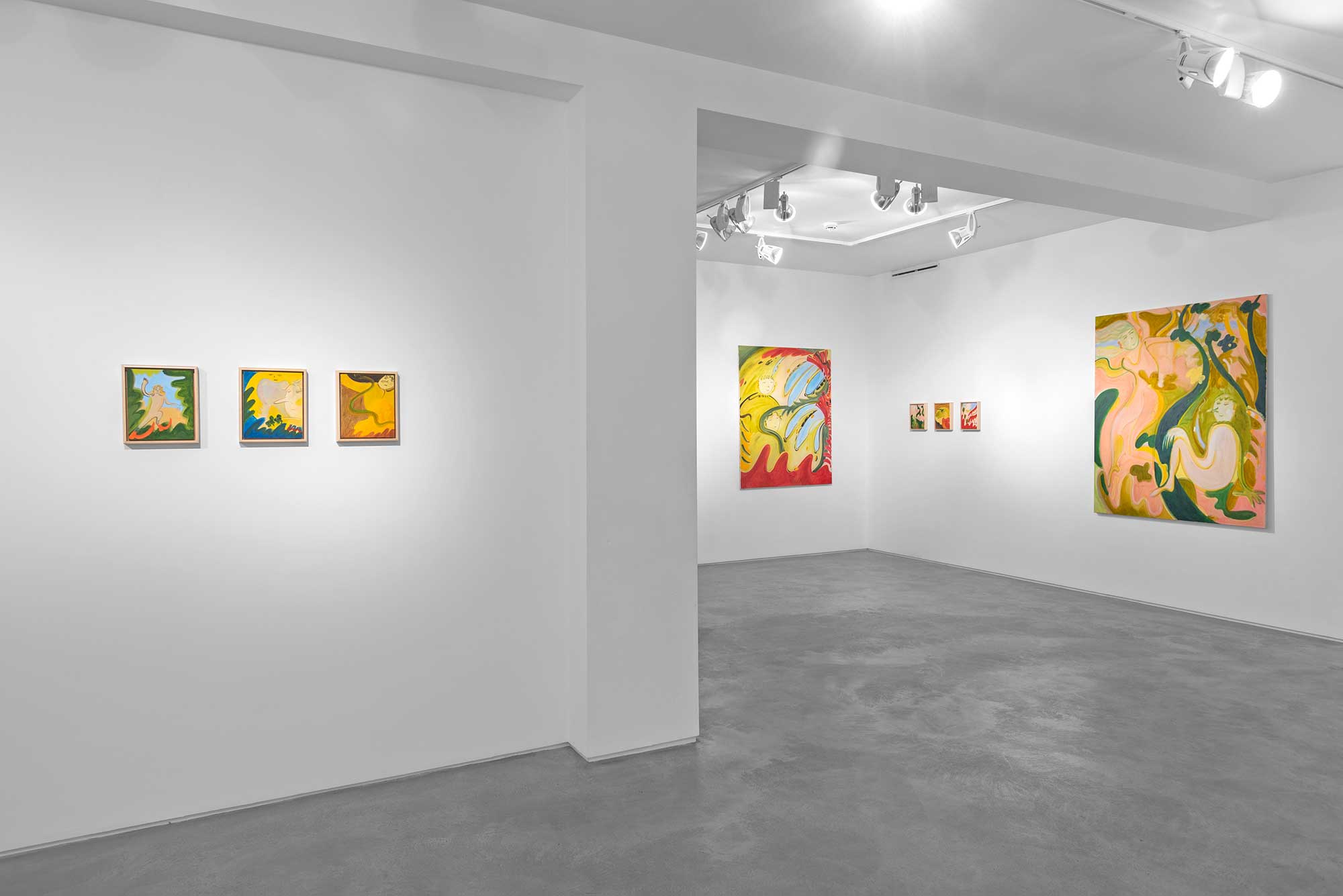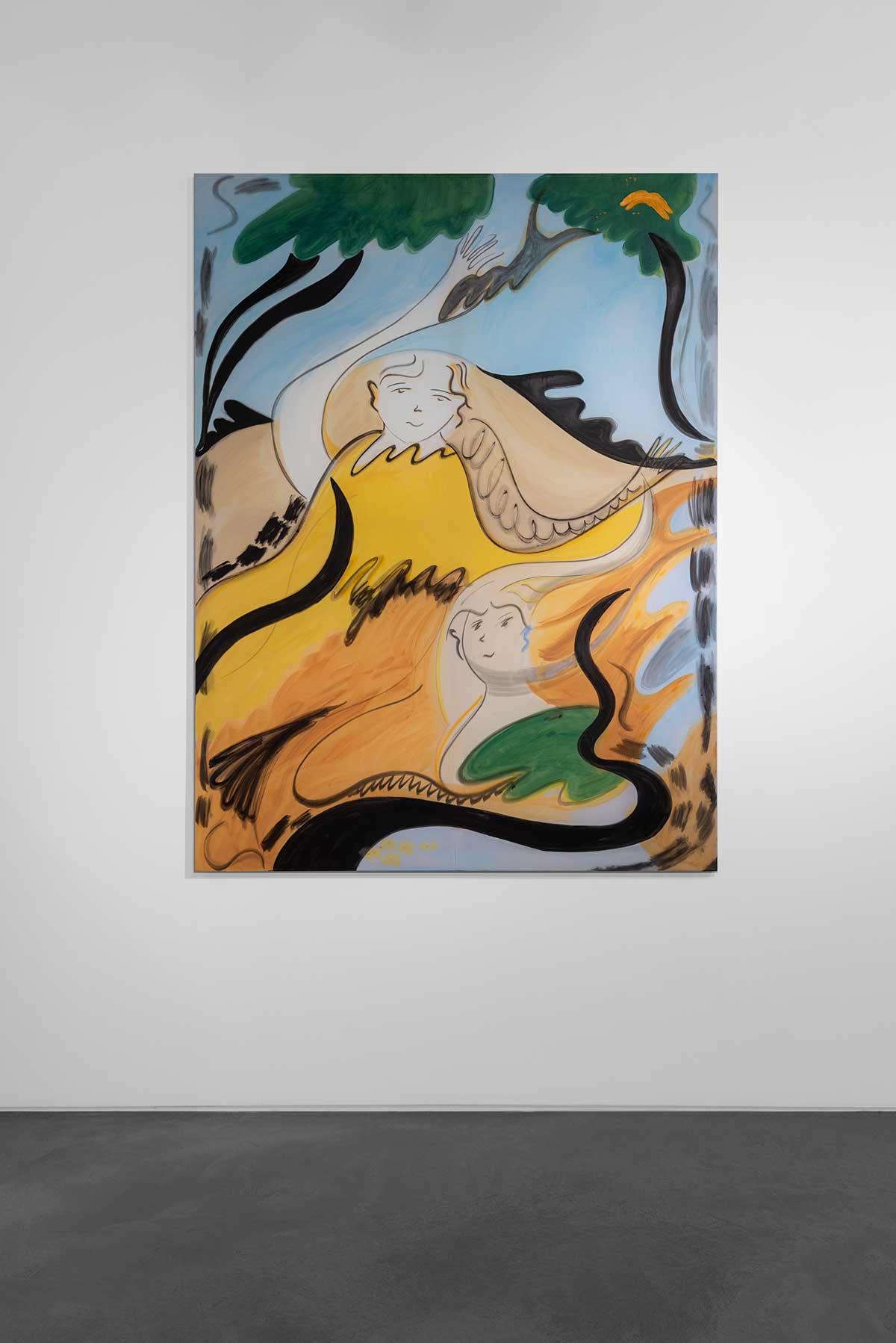Huxley-Parlour’s Director of Exhibitions Thea Gregory joined Yulia Iosilzon in her London studio to discuss her body of work, Fanfarria. Huxley-Parlour hosted the exhibition in February 2021.
TG Could you introduce us to this new body of work, Fanfarria, and the underlying ideas and influences at its conception?
YI I get fixated by colours, and this started really with a fixation with a colour palette of pinks, greens and orange. There is always something that sits on top of that, though. In this case, I’ve been inspired by a mixture of fairy tales, the animated propaganda of Japan, as well as elements of Jewish iconography, where every symbol and every colour means something.
TG Fairy tales! What was the particular impetus there, and were there any particular narratives that you were directly borrowing from?
YI I guess it’s not necessarily the full narratives of specific fairy tales, but elements and details from them that connect to the work. I suppose the main one I was inspired by was Jack and the Beanstalk… it best illustrates the idea of a magical world existing within our world. Especially the imagery from Japanese animated version of the story – I think made in 1974. I watched that version when I was a little girl, I still reference it in my paintings.
The idea of the beanstalk, powerful and magical, really inspired this body of work. I really want my works to flow, so the beanstalk, and the way it twists and turns as it grows into the sky, I used as a compositional element throughout the works. This notion of power and this notion of fantasy is really important in these works. It’s a kind of soft power, it is fantasy told with colour.
TG Soft power? Can you elucidate?
YI Because the subject matter might be powerful but the materiality is flowy… it’s tactile. I’ve got the power of the brushstroke and yet working on silk and with a washy, watercolour palette.
TG Yes, your paintings have a very strong physicality, and a unique tactile quality. Can you talk a little more about the surface of your paintings?
YI When I went to the Slade I was in sculpture before I moved to painting. So I had this sculptural mindset already. While I was still studying, I realised my works have a lot in common with sculpture and they retain sculptural elements. Back then I started to look for the fabric that I could use to get a feel of watercolour, within the sculptural field.
So I was thinking of how I could work with calligraphic lines and flowy colours on a material that would hold the idea, and would hold the layers, and the heavy brushstrokes. I started experimenting with different materials – different cottons and linens. But nothing felt right until the moment I discovered this eco-silk. There’s no name for this fabric – it’s not real silk. But immediately I felt a connection. It’s like a perfect formula that I can use, now, to help me with the ideas and how exactly I want my images to sit on the painting.
TG Can you talk a little more about your process, now, specifically?
YI It takes me about a week to make a painting. I plan my paintings beforehand and always lay them out with other paintings.
When I start, I already have in my mind how the colour will flow inside the painting. I make a lot of preparatory sketches beforehand. For me its important to feel confident, so I sketch to warm my hand so it feels really free when I make all the massive brushstrokes, all the calligraphical brush strokes on the surface of the paintings. All my mistakes have to happen when I make my small drawings – it is my safety net.
I lay my painting flat in my studio, usually I lay two or three of them flat. I work a few layers when they are flat to introduce colour. Then I wait. And my other layers, which are more calligraphically based, go on top of that when I put my painting vertical.
When my paintings lay flat I can control the density and saturation of the colours, which I would know beforehand where I need more and how I need to do the volumes. And which areas need to be more infused than others. And when vertical, I can work on the small details on faces, on intricacies of the composition.

TG So you are building up layers of paint as you are layers of reference.
YI Yes, I have a general idea of how I want the work to flow, so I make sketches and drawings before I approach the painting and its only then that I figure out where I put the elements, of people, or symbols. Characters represent moods and emotions and they come last to the paintings.
TG Have you always worked in this way, that colour comes first?
YI I have to connect to the colour first of all, and only then I develop layers by layers of the narrative, the meaning, and the other details. So usually colour comes first, but sometimes there could be something that I really want to put on paper or in my painting. Something that could be connected to linguistics, to metaphor, to something which is absolutely absurd.
TG Yes, your interest in linguistics comes through in the titles of the works but also in the subject matter. I understand you are interested in the idea of duality and double meanings, and layering up of different meanings?
YI Given that my fabric is transparent, for me it’s really interesting to get this duality and to reveal double meanings.
Sometimes when I have two drawings and I know that they would look great together if I merged them. So I will often merge multiple drawings in the painting. So if a drawing has any symbols, I can create the layers of meanings and layers of paints help intensify that, with my fabric. My fabric is a really special gem, I find it really easy to control, but it can also really surprise me. There’s always some intriguing narrative which will be revealed as I work through the painting. So as much as I want to control my process, it still surprises me when I actually transfer my sketches to the surface of the fabric.

TG You mentioned the beanstalk being a significant compositional element in the works, are there any other specific symbols that you were drawing on?
YI A fundamental tool of mine is thinking of the motif of a vicious circle, of flowing narratives that feed into one another. I’m interested in the idea of depicting something that ebbs and flows and that is not frozen in a moment. Its never directly shown or referenced, but it’s more like something you can refer to. Flowy lines that come from calligraphy, combined with this circular emblem, creates one space that all the other elements coexist inside of.
The vicious circle as a symbol came into my life when, as I was doing my dissertation, I came across the theories of Gilles Deleuze and Nietzsche, and started thinking about repetition. So I was thinking about constant repetition and the way I could really engage it within my paintings and drawings. Nietzsche is always in my mind, ever since I worked on my dissertation. I see him in my dreams(!)
The symbol of the snake relates so closely to the vicious circle – and its the symbol which you come across in Jewish iconography, in my case, and in many different religions, too, it means a lot of things. It’s my favourite animal, the snake. It has so many meanings. Within society, within religion… That symbol is also really helpful for me, as it is described so well by the kinds of brushstrokes I use. I always reuse ideas and I repeat my symbols in every single painting. So within these canvases the snake could become the beanstalk, or a river, or just a heavy brushstroke. It’s something that holds it all together.
As I mentioned, I tend to make groups of paintings at the same time. So, I lay them out, and repeatedly work on them in one flowing motion. So that they all use the same palette and shapes, they could be understood as a cartoon strip. All my works are stories that I’m telling. Making them simultaneously, I feel that the story is complete.
TG So you see Fanfarria as a complete story?
YI Yes I see the works for the exhibition as one story. I suppose it’s kind of two different stories in one story – the small ones are like something that we zoomed in on, a detail, a particular moment, and then something zoomed out, that we see the full landscape of, which are the large-scale paintings.
When I was working on the show, I kind of kept thinking about the metaphor of being underwater, which linguistically I started reshaping and rethinking. I suppose that is where a lot of the natural elements come from. Most of the sketches for this work were made during the [first] lockdown of 2020. I really needed some kind of motivation, I was going into my fantasy land to find some comfort, when these paintings were born, on paper, I was thinking about fantasies and dreams. I made them with these kindergarten colours, which seemed to me to feel right.
TG Yes, your use of bold colour as well as your particular visual language lends itself to narratives of fantasy and dreams.
YI Anything can happen on the surface of a painting… anything! I really try to make my paintings as filled with different symbols, emotions, and fantasies as possible. It’s the only way I can really get someone inside of my head, by putting all of that on the surface of my paintings.
I really do think that my paintings are a theatre of the absurd, where fantasies happen all at once in one space
